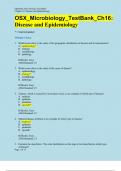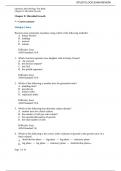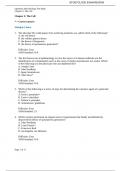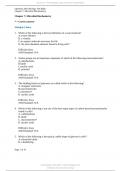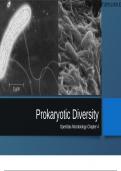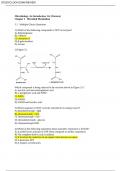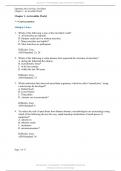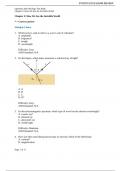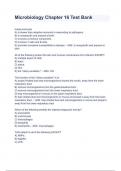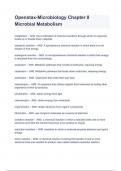St. Clair County Community College
Latest uploads at St. Clair County Community College. Looking for notes at St. Clair County Community College? We have lots of notes, study guides and study notes available for your school.
-
177
- 0
-
19
All courses for St. Clair County Community College
- BIO BACTERIA BIO BACTERIA 1
- BIOL 2117 BIOL 2117 1
- BIOL 251 BIOL 251 1
- BIOLOGY 12 1
- BIOLOGY 206 BIOLOGY206 79
- BIOLOGY 206 OpenStax Microbiology Test Bank Chapter 14: Antimicrobial Drugs BIOLOGY 206 OpenStax Microbiology Test Bank Chapter 14: Antimicrobial Drugs 3
- BIOLOGY 206 OpenStax Microbiology Test Bank Chapter 16: Disease and Epidemiology BIOLOGY 206 OpenStax Microbiology Test Bank Chapter 16: Disease and Epidemiology 2
- BIOLOGY 206 OpenStax Microbiology Test Bank Chapter 14: Antimicrobial Drugs 2
- BIOLOGY 206 OpenStax Microbiology Test Bank Chapter 16: Disease And Epidemiology 1
- BIOLOGY 206 OpenStax Microbiology Test Bank- Chapter 14: Antimicrobial Drugs 1
- BIOLOGY 206 OpenStax Microbiology Test Bank- Chapter 7: Microbial Biochemistry BIOLOGY 206 OpenStax Microbiology Test Bank- Chapter 7: Microbial Biochemistry 2
- BIOLOGY 206 OpenStax Microbiology Test Bank- Chapter 9: Microbial Metabolism BIOLOGY 206 3
- BIOLOGY 206 OpenStax Microbiology Test hapter 7: Microbial Biochemistry (BIOLOGY206OPENSTAXMICROBIOLO BIOLOGY 206 1
- Openstax microbiology testbank chapter 1: An invisible world 1
- Openstax microbiology testbank chapter 10: Biochemistry of the Genome 1
- Openstax microbiology testbank chapter 11: Mechanisms of microbial genetics 1
- OpenStax Microbiology testbank Chapter 12: Modern applications of microbial genetics 1
- Openstax microbiology testbank chapter 15: Microbial mechanism of pathogenicity 1
- Openstax microbiology testbank chapter 2 : How we see the invisible world 1
- Openstax microbiology testbank chapter 4 : Prokaryotic diversity 1
- Openstax microbiology testbank chapter 8: Microbial metabolism 1
- Openstax microbiology testbank chapter 9: Microbial growth 1
Latest notes & summaries St. Clair County Community College
1. Which term refers to the study of the geographic distribution of disease and its transmission? A. epidemiology* B. etiology C. morbidology D. pathology Difficulty: Easy ASM Standard: 23 2. Which term refers to the study of the cause of disease? A. epidemiology B. etiology* C. morbidology D. pathology Difficulty: Easy ASM Standard: 23 3. Tetanus, which is caused by Clostridium tetani, is an example of which type of disease? A. endemic B. epidemic C. pandemic D. sporadic...
OpenStax Microbiology Test Bank- Chapter 9: Review Bacteria most commonly reproduce using which of the following methods? A. binary fission* B. budding C. meiosis D. mitosis Difficulty: Easy ASM Standard: N/A 1. Which structure separates new daughter cells in binary fission? A. the crescent B. the division septum* C. the FtsZ D. the spindle apparatus Difficulty: Easy ASM Standard: N/A 2. Which of the following is another term for generation time? A. doubling time* B. growth rate...
OpenStax Microbiology Test Bank- Chapter 3 Review Multiple Choice 1. The idea that life could appear from nonliving materials was called which of the following? A. the cell theory B. the cellular genesis theory C. the theory of biogenesis D. the theory of spontaneous generation* Difficulty: Easy ASM Standard: N/A 2. The first known use of epidemiology to trace the source of a disease outbreak was the identification of contaminated water as the cause of cholera transmission in London. W...
OpenStax Microbiology Test Bank Chapter 7: Microbial Biochemistry Multiple Choice 1. Which of the following is the best definition of a macronutrient? A.a trace element B. a vitamin C.an organic molecule necessary for life D. the most abundant elements found in living cells* Difficulty:Easy ASM Standard: N/A 2. Amino groups are an important component of which of the following macromolecules? A.carbohydrates B.lipids C.nucleic acids D. proteins* Difficulty: Easy ASM Standard: N/A ...
OpenStax Microbiology Chapter 4 Prokaryotic Diversity. Identify and describe Identify and describe Identify and describe unique examples of prokaryotes in various habitats on earth Habitat and Functions • Ubiquitous organisms • Hot springs • Antarctic ice shield • Deep sea • Functions • Soil formation • Nutrient production • Recycling elements • Environmental cleanup Symbiotic Relationships • Community • Cooperative • Competitive • Relationship e...
OpenStax Microbiology test bank Chapter 5,6,7, and mastering chapter 8 1) Which of the following compounds is NOT an enzyme? A) dehydrogenase B) cellulase C) coenzyme A D) β-galactosidase E) sucrase 2) Figure 5.1 Which compound is being reduced in the reaction shown in Figure 5.1? A) isocitric acid and α-ketoglutaric acid B) α-ketoglutaric acid and NAD+ C) NAD+ D) NADH E) NADH and isocitric acid 3) Which organism is NOT correctly matched to its energy source? A) photoheterotrop...
OpenStax Microbiology Test Bank-Chapter 01: An Invisible World Multiple Choice 1. Which of the following is true of the microbial world? A. All microbes are harmful. B. Humans could survive without microbes. C. Many microbes are helpful.* D. Most microbes are pathogenic. Difficulty: Easy ASM Standard: 23, 24 2. Which of the following is when humans first suspected the existence of microbes? A. during the Industrial Revolution B. in prehistoric times* C. in the last century D. within...
OpenStax Microbiology Test Bank- Chapter 2: How We See the Invisible World 1. Which term is used to refer to a wave’s rate of vibration? A. amplitude B. frequency* C. trough D. wavelength Difficulty: Easy ASM Standard: N/A 2. On the figure, which letter represents a refracted ray of light? A. A B. B C. C D. D* Difficulty: Easy ASM Standard: N/A 3. On the electromagnetic spectrum, which type of wave has the shortest wavelength? A. cosmic ray* B. infrared ray C. ultraviolet ray...
Microbiology Chapter 16 Test Bank Complete Questions And Answers Innate immunity A) is slower than adaptive immunity in responding to pathogens. B) is nonspecific and present at birth. C) involves a memory component. D) involves T cells and B cells. E) provides increased susceptibility to disease - ANS is nonspecific and present at birth All of the following protect the skin and mucous membranes from infection EXCEPT A) multiple layers of cells. B) tears. C) saliva. D) HCl. E) ...
Openstax-Microbiology Chapter 8 Microbial Metabolism Exam Questions And Well Verified Answers metabolism - ANS the combination of chemical reactions through which an organism builds up or breaks down materials exergonic reaction - ANS A spontaneous chemical reaction in which there is a net release of free energy. endergonic reaction - ANS A non-spontaneous chemical reaction in which free energy is absorbed from the surroundings. anabolism - ANS Metabolic pathways that construct...

